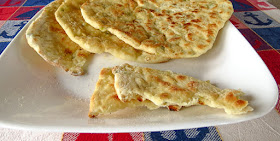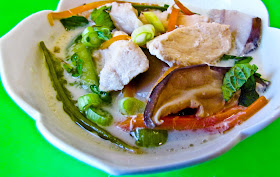Sigh! my photos are traveling, lost somewhere in the blogosphere, so here's a placeholder; a post with a not-so-wonderful scone from Tim Hortons. Updates to come whenever I track down those pesky traveling photos.
It's HOT outside, the air conditioner has been going full blast... and I'm baking scones?! What's up with that? Typically we don't love scones, often finding them too dry and crumbly, not as tasty as sweet or savory drop biscuits. But the second week of August is unofficially International Scone Week, a tradition begun by Celia in 2011 (link), now hosted by Tandy at Lavender and Lime, and I couldn't resist an early morning bake. Good decision, since this small batch of Apple Buttermilk Scones was a winner.
The scones sported a toothsome crispy crust and a meltingly tender interior, more reminiscent of an apple cake or quickbread rather than my (obviously incorrect) memories of dry, disappointing scones. While the glaze was a tasty addition, it wasn't necessary... especially since RL added butter and jam to each split half. Half-batch baking provided breakfast and a shared snack later in the morning, with no pesky leftover scones to dry out on counters or fridge. Thanks, Tandy, for nudging me into baking this delicious taste treat.
The base recipe came from Jen at bakedbyanintrovert, click here for her original full-batch recipe. Below is my slightly adjusted, half-batch version for #ISW2018.
Apple Buttermilk Scones
yields 4 fat sconesIngredients
- 1 and 3/8 cups all-purpose flour
- 1/4 cup light brown sugar, firmly packed
- 1/2 tablespoon baking powder
- 1/4 teaspoon baking soda
- 1/2 teaspoon salt
- 1 and 1/2 teaspoon Penzey's Apple Pie Spice
- 2 tablespoons buttermilk powder
- 1/4 cup chilled or frozen butter, grated
- 3/4 cup chopped fresh apple, unpeeled 1/2" pieces
- 1/2 cup milk
- 1/2 tablespoon vanilla extract
- 1 tablespoon heavy cream
- 1 teaspoon vanilla sugar
For the glaze (optional)
- 1/2 cup confectioners' sugar
- 1-2 tablespoons apple juice
Directions
- Whisk or sift the flour, brown sugar, baking powder, baking soda, salt, Apple Pie Spice and buttermilk powder together. Add the chilled, grated butter into the flour mix and combine using your fingertips until the mixture looks like coarse crumbs.
- Gently fold in the apples. Whisk the vanilla and the milk together and gradually add half of it to the flour mixture. Stir just until the dough comes together. Add more milk as needed. a little at a time until the mixture is moist but not too wet. Do not over mix the dough. Place the bowl of dough in the freezer while you place an oven rack in the center of the oven and preheat to 400 F.
- When the oven reaches 400 F, transfer the dough to a lightly floured surface and gently knead the dough four or five times. Pat the dough into a square and cut from corner to corner into four triangles. Arrange the scones 2 inches apart on a baking sheet lined with a silicone mat or parchment paper.
- Lightly brush the top of each scone with heavy cream. Sprinkle lightly with vanilla sugar. Bake for 20-25 minutes or until golden brown. Transfer to a wire rack to cool and drizzle with glaze.Optional Glaze: Sift powdered sugar into a small bowl; whisk or stir in apple juice in small amounts until desired consistency.Note: One scone is very filling so next time I will use the half-batch recipe to create 8 smaller scones.(and then eat 2 of them, no doubt).






























